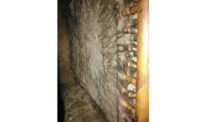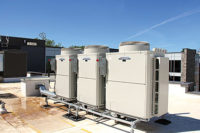As commercial building codes and regulations mandate increasingly efficient commercial HVAC equipment, some manufacturers are going above and beyond by offering products that provide optimal occupant comfort and health while often far exceeding energy-efficiency requirements. While some building owners have the capital to make such investments when their HVAC equipment nears the end of its life cycle, many school districts are struggling just to pay for routine maintenance on their aging equipment and simply can’t afford high-efficiency upgrades.
But, it doesn’t have to be that way. According to the manufacturers that make equipment for schools, there are often many options available to districts looking to make those much-needed upgrades.
Products Flaunt Efficiency, Comfort
Numerous manufacturers offer products that fit the needs of school buildings, both in new construction and retrofit projects.
“WaterFurnace offers a wide range of products for the school market,” said Alan Niles, western region commercial sales manager, WaterFurnace Intl. Inc. “A popular choice for individual classrooms is the Envision2 Compact, our dual capacity scroll compressor product with ECM fan motor. Despite being our most efficient product line, we were able to reduce its horizontal cabinet by 20 inches in length versus the model it replaces, thereby making it easier to retrofit into older buildings.”
Niles said the company’s water-to-water heat pump products can be used for preheating and precooling outside air and for preheating domestic hot water for the school. “Our new CLW Series large commercial chiller with a six-pipe simultaneous hot water/chilled water option offers a new solution to replace older central plants,” he added.
Mike Smith, senior product marketing manager, Mitsubishi Electric US Cooling and Heating Division, said variable refrigerant flow (VRF) is becoming a very popular option in educational facilities. “VRF zoning systems provide one of the most flexible, cost-effective, and environmentally friendly options in commercial and institutional construction today. VRF zoning technology provides precise comfort control and is particularly well suited for single- or multi-story buildings with multiple zones that require individual comfort control (such as classrooms and administrative areas). Our P-Series single-zone split-ductless systems are perfect for classrooms, modular classrooms, offices, and computer and equipment rooms.”
Greg Alcorn, vice president, commercial sales and marketing, Carrier Corp., said schools often opt for the company’s intelligent i-Vu® building automation system in order to reduce overall energy consumption. “This solution combines Carrier commercial equipment — including WeatherExpert™ rooftops, VRF, AquaEdge™ chillers, and more — with plug-and-play controllers and a Web-based interface to form a cohesive, intuitive building automation system. With the i-Vu system, school districts and their facility managers can view and control their HVAC systems from anywhere in the world using a standard Web browser or a device enabled with a wireless access point (WAP), such as a smartphone, tablet, or computer.”
Jackson Willis, Mid-Atlantic sales engineer for Fujitsu General America Inc., also said VRF is becoming increasingly popular in educational facilities. “Fujitsu offers a full line of mini splits and multi-zone splits with our Halcyon line and a full line of VRF equipment with our Airstage line,” he said. “Both products have many applications in K-12 and post-secondary education.”
Schools typically want to reduce operating costs, improve IAQ, and minimize sound, said Don Winter, director of marketing communications at Daikin Applied. “The best solution will depend on the size of the building, customer requirements, and if the project is an upgrade/replacement in an existing building or new construction. Daikin Applied’s most popular HVAC solutions for schools include the Rebel, Maverick II, and RoofPak rooftop units; SmartSource water-source heat pump solutions; air-cooled scroll and Pathfinder screw chillers; Magnitude magnetic bearing centrifugal chillers; vision air handlers; and replacement unit ventilators.”
Holly Van Straten, product manager, Modine Mfg. Co., said Modine strives to offer options for administrators looking to upgrade. “Modine offers vertical, single-packaged HVAC systems in multiple configurations, including the Airedale ClassMate® model DX cooling and heat pumps, the Airedale SchoolMate® ground/water-source heat pump, and the Airedale Sentinel hot/cold water unit ventilator,” she said. “We also offer Airedale Varsity traditional under-the-window unit ventilators. For schools that prefer a rooftop unit to bring ventilation air inside, Modine offers the Atherion® packaged ventilation system. Available in two cabinet sizes, the Atherion is available with an optional energy recovery module in 7-30-ton capacities.”
For schools looking to reduce the load on their HVAC system, Greenheck offers a variety of products to help pre-condition the air entering the system. “Our lineup includes energy recovery pre-conditioners, dedicated outdoor air equipment, and air-handling equipment for constant-volume or variable-air-volume (VAV) applications,” said Becky Gatzke, general manager, tempered air products, Greenheck Fan Corp. “All of this equipment is available with energy recovery wheels to reduce the heating and cooling load by transferring energy from the exhaust or relief air to the outdoor airstream. This reduces the first cost of the system by allowing designers to downsize their cooling equipment and reduces operating costs by decreasing both the heating and cooling loads.”
For schools looking to improve IAQ while saving energy, Rotobrush Intl. LLC offers air duct cleaning equipment to “provide a thorough cleaning of air ducts and eliminate airborne pollutants that can make their way to the indoor air,” said Bob Elledge, president of Rotobrush. “The R5000 Negative Air Machine is a powerful and portable vacuum system that thoroughly cleans supply, intake, and return ducts throughout the facility and removes dust and debris that can build up and pollute the air. The aiR+® XP Air Duct Cleaning System can handle commercial jobs and uses a brush and vacuum method to easily maneuver through ductwork and clean up air ducts by removing pollutants. Both of these products help to improve the quality of the indoor air and ensure the HVAC system in school facilities is running efficiently and properly.”
How to Finance Upgrades
Even with so many product options available, the most difficult task many school administrators face when upgrading their facilities’ equipment is finding the money to do it. But, there are options available, including utility rebates, energy savings performance contracts, and financing options.
“Even with a shifted priority toward investing in high-performance products, some schools may not be able to finance the entire investment upfront,” Smith said. “Fortunately, all levels of government and utility companies realize that making our schools energy efficient is a wise investment, and there are many incentive options available to offset the cost. Incentives in the form of grants, tax credits, and rebates are available on the federal, state, and municipal levels — and from utility companies. Dsireusa.org is a great database for schools to identify which programs are most applicable.”
Niles said many public schools still rely on local bond issues for major improvements, though some have been turning to energy savings companies (ESCOs) to finance renovation projects. In that situation, “the ESCO is paid using the money saved in utility costs over a fixed period of time,” he said.
Niles added that local utilities still play a role in providing incentives. “Schools can receive reduced rates by reducing their peak demand load by using a WaterFurnace system, and electric utilities provide incentives for using all electric systems,” he said.
Van Straten agreed ESCOs are becoming more popular options for schools looking to fund retrofit projects. “The advantage of an ESCO is that it allows schools to add newer, higher-efficiency equipment without having to obtain new tax revenue from the community,” she said. “It allows them to use energy savings to pay for new equipment, resulting in a cash-neutral situation. And, as a form of insurance for the schools, if the new equipment isn’t providing the savings promised by the ESCO, the ESCO can make up the difference to the school.”
In some cases, schools can take advantage of direct financing and other assistance directly from the manufacturer. Alcorn said Carrier offers “a commercial financing program that is flexible and easy, including terms of 24-60 months with zero dollars down for qualified users.” The program covers the Carrier equipment as well as all other related expenses on the project. Carrier also helps administrators and district officials locate and remediate costly energy drains on school buildings through a Carrier energy assessment specifically tailored to the needs and requirements of K-12 educational facilities. The assessment is performed on-site by Carrier efficiency experts and typically provides savings that will offset the cost of the study within the first two years of implementation, with additional savings accruing over time.
Willis said schools need to factor in operation and maintenance savings when financing new construction or renovation projects, adding that third-party financing companies take building efficiency into account. “Energy performance contracts are a growing business, and many ESCOs are increasingly using VRF as a solution in their projects,” he added.
Winter said Daikin Applied works with each customer to develop a solution that meets their needs and budget requirements, both today and in the future. “As needed, we can facilitate third-party financing options,” he said. “Daikin Applied also offers many solutions on the federal GSA [general services administration] schedule. Some education customers may be able to use the GSA schedule to purchase Daikin Applied solutions. We also involve utilities to provide rebates for high-efficiency solutions.”
Elledge said Rotobrush helps defer the cost of purchasing its products by offering public and private institutions a 10 percent discount. “The air duct cleaning products are extremely portable and easy to use, which means staff can handle the equipment without having to hire outside services,” he added.
Where Is the School Market Going?
While times are hard now for many schools, some manufacturers believe an improving economy and increasing availability of alternative financing options will soon make it easier for schools to get the funding necessary for upgrades. And, in the meantime, HVAC products will continue to improve in energy efficiency, ease of installation, and life cycle.
“We see an increasing trend to replace older, less efficient units that are still operating with new solutions that are much more energy efficient,” Winter said, adding that, as building codes require increased energy efficiency and improved IAQ, companies like Daikin are working to meet and exceed those standards.
Niles predicted the school market will see a surge of growth in both new construction and renovation projects. “Energy efficiency is becoming the first design criteria,” he said. “A Pre-purchase agreement (PPA) is growing in popularity in the private sector and can be used more often for schools. And the influence of the EPA’s recent 111D ruling for states to reduce CO2 emissions could result in local CO2 cap-and-trade programs. High-efficiency systems may soon be paid for by other state entities buying and selling CO2 emission offsets.”
Smith predicted schools will continue to pursue energy savings performance contracts in order to fund large-scale improvements. “The school system often uses the savings to pay back the investment in the systems. ESCOs are responsible to pay the difference if projects do not provide the expected return on investment,” Smith said.
Van Straten agreed the school market will “see ESCOs growing in popularity” in coming years. “In addition, as we come out of the recession, some communities are beginning to warm up to the idea of reinvesting in their schools after having ignored them for so long. This could open up more avenues for increases in spending on HVAC equipment.”
In the meantime, some manufacturers are working closely with school leaders to figure out the best solution for their needs and budgets.
“Carrier continues to educate administrators and district officials on system design and alternatives,” Alcorn said. “Education, detailed upfront analysis, and a comprehensive systems approach provide the best opportunities to justify projects. Recognizing that each building is unique, Carrier offers a full range of product and system solutions, energy-assessment programs, and analytical tools to address each customer’s performance, financial, and environmental requirements.”
Willis said schools “will continue to follow trends of the greater society with a stronger push toward more and more efficient buildings,” and that high-efficiency HVAC solutions, such as VRF, will be a huge part of that push for efficiency.
“Public and private school systems will find new and innovative ways to help finance solutions that will save them money in the long term with reduced operations costs,” he added.
Publication date: 8/4/2014
Want more HVAC industry news and information? Join The NEWS on Facebook, Twitter, and LinkedIn today!









